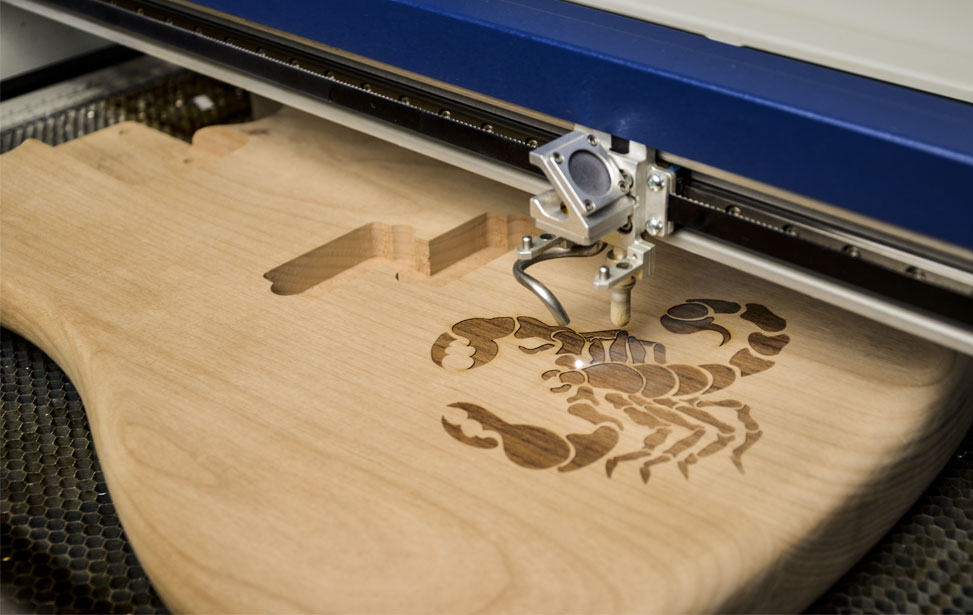Engraving has essentially been carried out on various substrates using different types of tools. It involves the tool revolving at high speed & cutting/engraving the material depending upon the feed applied. This engraving is a ‘contact’ process i.e. the tool is in contact with the material being cut or engraved upon. These tools are required to be suitably ground & sharpened in order to achieve the desired effects. The advent of laser technology led to the use of lasers for engraving. As with mechanical engraving machines, laser engraving is also carried out on a wide spectrum of substrates and does not involve the use of any tools. It is a ‘non contact’ process and the cutting/engraving is performed by an intense laser beam. Lasers make engraving easy using various graphics software packages that are easily available.
The term ‘laser’ is an acronym for ‘Light Amplification by Stimulated Emission of Radiation’. Lasers are devices that amplify light & can be made extremely intense & directional. Lasers harness atoms to store and emit light. To do this, the electrons in the atoms of a laser medium are first pumped or energised to an excited state by an energy source. The atoms are then ‘stimulated’ by external photons to emit the stored energy in the form of photons (stimulated emission). The emitted photons have a frequency characteristic of the atoms and travel in step with the stimulating photons. These photons in turn stimulate other excited atoms that release more photons. Light amplification is thus achieved as the photons move back and forth between two parallel mirrors, triggering further stimulated emissions. The resulting build up in number of photons is emitted in the form of an intense laser beam.
There are different kinds of lasers for different applications. They are generally referred to depending upon the laser medium used. They can be generally classified as solid state, gas, semiconductor or liquid lasers. Many types of laser mediums exist some of which are: Argon, Carbon Dioxide (CO2), Diode, Dye, Excimer, Helium-neon, Neodymium-glass, Neodymium-YAG, Nitrogen, Molecular-hydrogen, & Ruby. The most common lasers for industrial applications are CO2, Neodymium-YAG (NdYag) & Excimer.
Laser engraving machines are driven by PC compatible omputers. The laser interfaces with the computer using graphics software including but not limited to CorelDRAW, Adobe Illustrator, Adobe Pagemaker, AutoCAD & AutoCADlite.
Proprietary Windows based print drivers are provided by various manufacturers of laser engraving machines that facilitate direct printing/engraving from these software packages and also control the laser functions. Files of various formats are converted into a language that drives the laser engraver.
The engraving machines for the signage and graphic industry would most commonly use CO2 lasers followed by ND- YAG. CO2 lasers are very versatile & find applications in a variety of industries. CO2 lasers can engrave, mark or cut nearly any non-metallic material. These include wood, acrylic, plastic, melamine, rubber, leather, fabric, paper, plastic film, matboard, ceramic, glass, and marble to list a few. They are also effective on coated, painted and anodised metals. A laser engraver is very much like a printer where instead of applying toner to paper, the laser beam incinerates away the substrate material in two ways – Raster (engraving) & Vector (cutting).
Lasers engraving is commonly used for applications like plaques, awards, rewards, recognitions, mementos, rubber stamps, desk accessories, name badges, decorative etching, signage, giftware, industrial gaskets, templates, atterns, overlays, masks, stencils, membrane switches, flexible circuits, architectural models, 2-D prototyping, part numbering & identification, control panel manufacturing, identification tags, marquetry etc. The list can be endless.
Using a rotary attachment laser engraving can be carried out on cylindrical objects like glasses, mugs, spheres, rods, etc. Laser engraving machines can also be provided with a ‘dual’ head, which facilitates simultaneous engraving thereby doubling production and reducing production time. This is especially very useful where large production runs are to be carried out.
Sign makers are increasingly using laser technology for providing quality products and services to their customers since it has an edge over other technologies. Laser engraving produces a non-contact mark which results in less wear and tear on tooling and associated costs. The chances for product damage and deformation are less and there is no problems in disposing of toxic by-products. The machines are easy to operate and maintain. Though the laser technology has come down dramatically in price since it’s inception, it is still an expensive technology and has its own limitations. A laser still cannot compete with a router when it comes to removing large areas of artwork. It also poses some safety hazards.Â
*The author is a pioneer in the state of the art technology of laser engraving for the signage & graphic industry. His firm, SOLAR (India) in Mumbai, representing Epilog Inc, USA in India for their range of ultra high precision laser engraving machines, specialises in signages and create various products effectively using this technology.


Comments are closed.